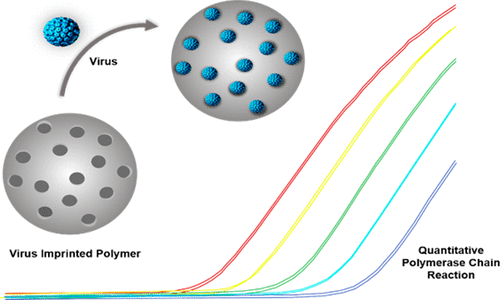当前位置:
X-MOL 学术
›
Anal. Chem.
›
论文详情
Our official English website, www.x-mol.net, welcomes your feedback! (Note: you will need to create a separate account there.)
Enhanced Selectivity by Passivation: Molecular Imprints for Viruses with Exceptional Binding Properties
Analytical Chemistry ( IF 7.4 ) Pub Date : 2018-03-05 00:00:00 , DOI: 10.1021/acs.analchem.7b05148 Manuela Gast , Stefanie Kühner 1 , Harald Sobek 1 , Paul Walther , Boris Mizaikoff
Analytical Chemistry ( IF 7.4 ) Pub Date : 2018-03-05 00:00:00 , DOI: 10.1021/acs.analchem.7b05148 Manuela Gast , Stefanie Kühner 1 , Harald Sobek 1 , Paul Walther , Boris Mizaikoff
Affiliation

|
Inspired by the recognition processes found in biology such as enzyme–substrate and antibody–antigen interactions, synthetic systems with comparable molecular recognition properties have been investigated during recent years based on molecular imprinting strategies. While materials with recognition capabilities for small molecules (i.e., with low molecular weight) have achieved substantial advancements, the synthesis of molecularly imprinted materials with virus recognition properties remains challenging to date. Likewise, protein–surface and protein–protein interactions are essential for a wide variety of biological applications in biotechnology. In biological sensor technology the coating of surfaces to prevent nonspecific adsorption interactions plays an important role. Particularly, polyethylene glycol (PEG) stands out for its high performance in preventing proteins from nonspecifically interactions. However, blocking agents such as the protein bovine serum albumin (BSA) can also be useful as unspecific binding prevention agents for passivation, without modification of the surface. Herein the influence of blocking agents as unspecific reaction components is investigated on the enhancements of selectivity from adenovirus-imprinted particles, whereas adenovirus was used as target species in molecular imprinting. Furthermore, quantitative polymerase chain reaction (qPCR) was used for the first time as virus quantification approach in this context.
中文翻译:

通过钝化提高选择性:具有出色结合特性的病毒分子印迹
受生物学中发现的识别过程(例如酶-底物和抗体-抗原相互作用)的启发,基于分子印迹策略,近年来已对具有可比的分子识别特性的合成系统进行了研究。尽管具有对小分子(即低分子量)的识别能力的材料已经取得了重大进展,但迄今为止,具有病毒识别特性的分子印迹材料的合成仍然具有挑战性。同样,蛋白质-表面和蛋白质-蛋白质的相互作用对于生物技术中各种生物学应用都是必不可少的。在生物传感器技术中,防止非特异性吸附相互作用的表面涂层起着重要作用。特别,聚乙二醇(PEG)以其在防止蛋白质非特异性相互作用方面的高性能而出众。然而,诸如蛋白牛血清白蛋白(BSA)的封闭剂也可以用作钝化的非特异性结合防止剂,而无需对表面进行修饰。在本文中,研究了封闭剂作为非特异性反应组分对腺病毒印迹颗粒选择性增强的影响,而腺病毒被用作分子印迹中的目标物种。此外,在这种情况下,定量聚合酶链反应(qPCR)首次用作病毒定量方法。诸如蛋白质牛血清白蛋白(BSA)的封闭剂也可以用作钝化的非特异性结合防止剂,而无需对表面进行修饰。在本文中,研究了阻断剂作为非特异性反应组分对腺病毒印迹颗粒选择性增强的影响,而腺病毒被用作分子印迹中的目标物种。此外,在这种情况下,定量聚合酶链反应(qPCR)首次用作病毒定量方法。诸如蛋白质牛血清白蛋白(BSA)的封闭剂也可以用作钝化的非特异性结合防止剂,而无需对表面进行修饰。在本文中,研究了阻断剂作为非特异性反应组分对腺病毒印迹颗粒选择性增强的影响,而腺病毒被用作分子印迹中的目标物种。此外,在这种情况下,定量聚合酶链反应(qPCR)首次用作病毒定量方法。
更新日期:2018-03-05
中文翻译:

通过钝化提高选择性:具有出色结合特性的病毒分子印迹
受生物学中发现的识别过程(例如酶-底物和抗体-抗原相互作用)的启发,基于分子印迹策略,近年来已对具有可比的分子识别特性的合成系统进行了研究。尽管具有对小分子(即低分子量)的识别能力的材料已经取得了重大进展,但迄今为止,具有病毒识别特性的分子印迹材料的合成仍然具有挑战性。同样,蛋白质-表面和蛋白质-蛋白质的相互作用对于生物技术中各种生物学应用都是必不可少的。在生物传感器技术中,防止非特异性吸附相互作用的表面涂层起着重要作用。特别,聚乙二醇(PEG)以其在防止蛋白质非特异性相互作用方面的高性能而出众。然而,诸如蛋白牛血清白蛋白(BSA)的封闭剂也可以用作钝化的非特异性结合防止剂,而无需对表面进行修饰。在本文中,研究了封闭剂作为非特异性反应组分对腺病毒印迹颗粒选择性增强的影响,而腺病毒被用作分子印迹中的目标物种。此外,在这种情况下,定量聚合酶链反应(qPCR)首次用作病毒定量方法。诸如蛋白质牛血清白蛋白(BSA)的封闭剂也可以用作钝化的非特异性结合防止剂,而无需对表面进行修饰。在本文中,研究了阻断剂作为非特异性反应组分对腺病毒印迹颗粒选择性增强的影响,而腺病毒被用作分子印迹中的目标物种。此外,在这种情况下,定量聚合酶链反应(qPCR)首次用作病毒定量方法。诸如蛋白质牛血清白蛋白(BSA)的封闭剂也可以用作钝化的非特异性结合防止剂,而无需对表面进行修饰。在本文中,研究了阻断剂作为非特异性反应组分对腺病毒印迹颗粒选择性增强的影响,而腺病毒被用作分子印迹中的目标物种。此外,在这种情况下,定量聚合酶链反应(qPCR)首次用作病毒定量方法。



























 京公网安备 11010802027423号
京公网安备 11010802027423号